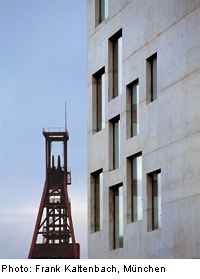A Hundred Days at the Zollverein - Architecture and Design at Europe's most attractive Coal Mine

Coal was mined and processed at the “Zollverein” for 136 years, down to its closure in 1986. With the construction of the Zollverein School and the opening of the design and architectural exhibition “Entry”, a major part of a long restructuring process has come to a end. Pit XII with its tower, built by Fritz Schupp and Martin Kremmer between 1928 and 1932, is still emblematic of the mine. In 1997, Norman Foster converted the former boiler house into the Design Centre North Rhine-Westphalia; but only since UNESCO declared the mine to be part of the World Cultural Heritage in 2001 has Brussels provided adequate support funds, allowing a long-held wish of the region to be realized, namely the creation of a museum for the natural and cultural history of the Ruhr area (see Detail 6/1997).
The building, 90 x 30 m on plan and up to 47 m high, was converted by Rem Koolhaas in collaboration with Heinrich Böll and Hans Krabel. Koolhaas was also responsible for the master plan. In view of strict conservational conditions, however, the design measures were very restrained.
Before the Ruhr Museum finally moves into these spaces, the 6,000 m2 area will host the exhibition “Entry” until 3 December 2006 (ill. 2). “Talking Cities”, an exhibition within the exhibition, shows on a transdisciplinary basis the potential of waste areas and the impact that modest but effective measures can have.
In August, the brilliant white concrete cube of the Zollverein School of Management and Design by the Japanese architects SAANA was completed – the only building in the complex not in the reddish-brown colours of brick and steel construction (ills. 3, 4). Here, the flow of warm pit water through the concrete outer walls obviated the need for conventional thermal insulation (see Detail 12/2005).
The singular flair of this industrial complex has attracted artists for years. In future, new design offices will be encouraged to move here, and the construction of dwellings and a hotel is envisaged. The greatest structure of all, however, remains invisible and unfortunately inaccessible, namely an entire underground city with a network of routes 120 km long and extending up to 1.2 km into the earth.
